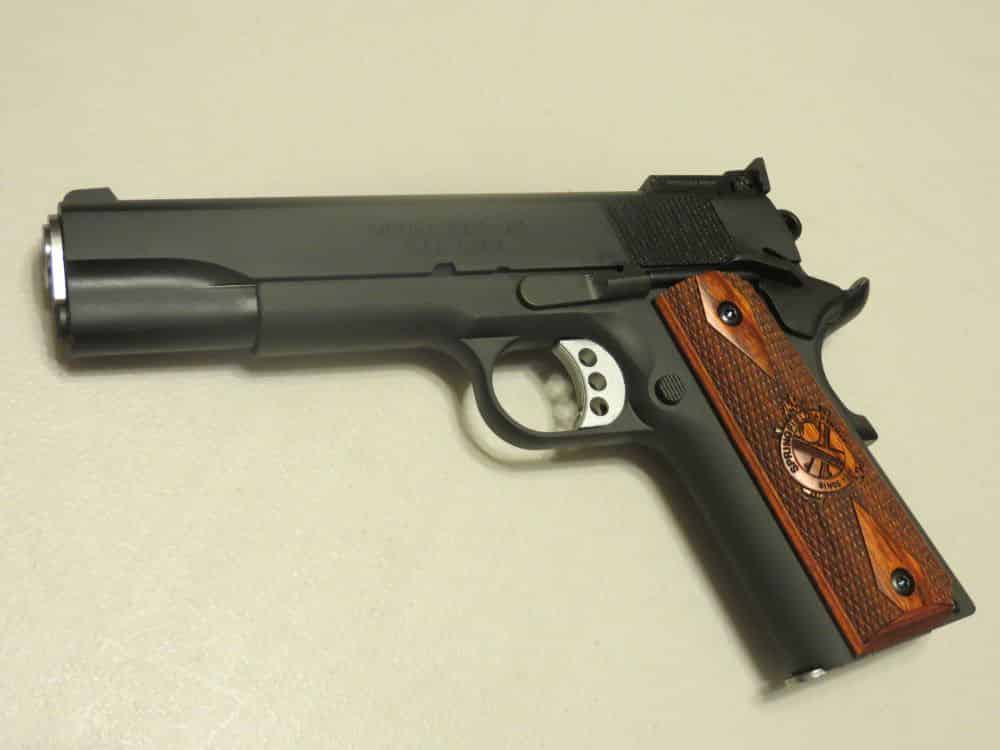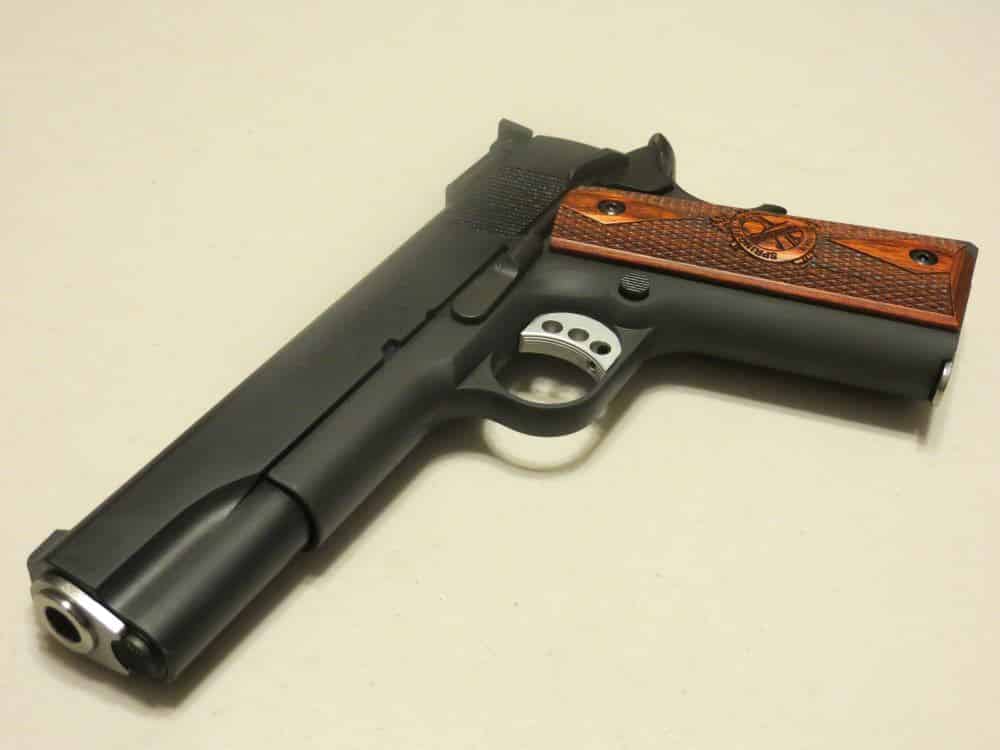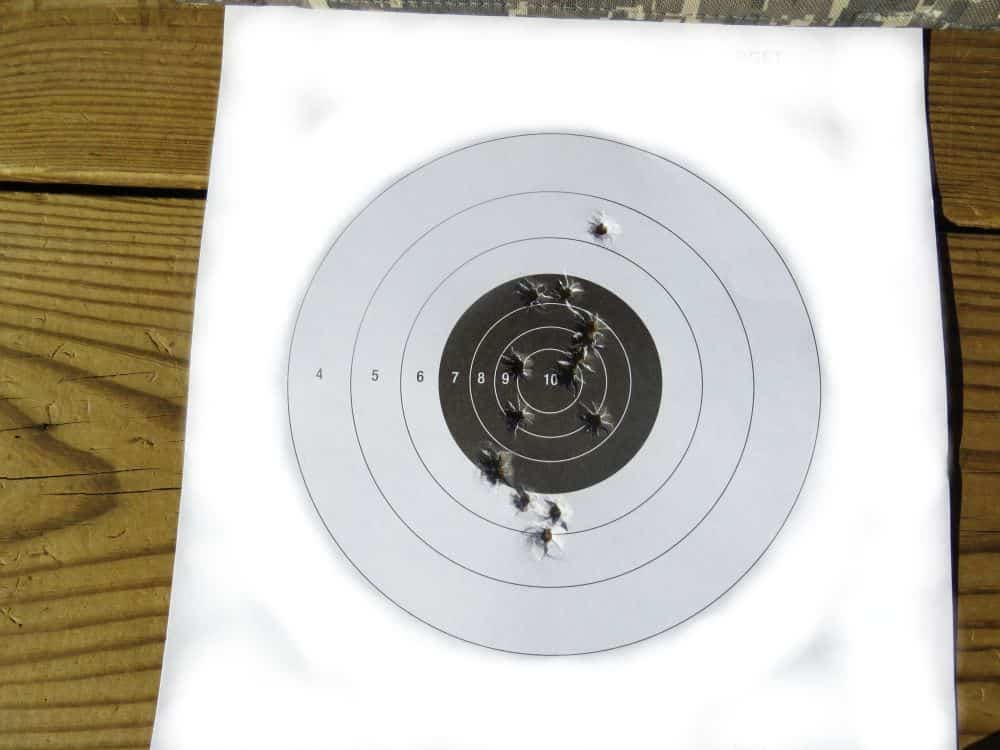Table of Contents
For some time, 1911 aficionados and International Defensive Pistol Association competitors have wanted a reasonably-priced alternative single-action, single-stack gun in 9mm without a lot of “whistles and bells” that will be reliable to complement the 1911 in .45 caliber. Well, Springfield-Armory has introduced a new 1911 Range Officer (RO) in 9mm in early 2014. Of course, there are others in the market, like the Smith & Wesson 1911 Pro Series in 9 mm. It has a reputation as a very accurate entry-level custom 1911 in 9 mm with several nice features, including stainless finish, adjustable rear sights, 2 ten-round Wilson mags, and a magwell. I will review it soon. Some purists still think the 1911 must be only chambered in .45 caliber or else it is blasphemy. Others say a 1911 in 9mm is asking for problems because they, in general, are so finicky, have feeding problems with a ramped barrel and certain types of ammo, and jam a lot. For me, I think a 9mm 1911 is a fine alternative for consideration for improved accuracy in competition shooting with less felt recoil, as well as being cost-effective and viable for range and maybe home defense purposes. But, it must be reliable. It is my opinion that fast, accurate shot placement is the major variable to surviving any self-defense scenario, as well as performing well in competitive matches. So, make sure you are comfortable with a 1911 in 9mm from a safety, operational, tactical and other use perspective. Certainly, 9mm ammo is less costly than .45 ammo and this translates into more practice time. Today’s improved 9mm cartridges (especially hollow points and +P) with their increased velocities and muzzle energies, penetration, and expansion properties make the differences in one-shot stop percentages really close. Some quote the .45 caliber one-shot stop percentage as 87%, with the 9mm one-shot stop percentage being close at 83%. Almost a negligible difference for peace-of-mind purposes. Given our present ammo predicament, the reduced supply, and its high costs, I just want to go to the range and plink frequently, comfortably, accurately, and have fun at a reasonable cost. I don’t want to worry about malfunctions, stoppages, jams, and reliability issues. So, is the RO an option to do so, in addition to being a consideration as a competition gun. Will it live up to all the expectations? Well, I shot it and studied it, and want to offer my report.
01
of 03
2014 Springfield Armory 1911 Range Officer Specifications
| Ninja Column 1 | Ninja Column 2 |
|---|---|
| MSRP | $977 |
| Other | Lowered & Flared Ejection Port |
| Safeties | High-Hand Beavertail Grip; ExtendedManual Thumb - Single Sided |
| Weight | 8.5" |
| Height | 5.5" |
| Recoil System | Standard Guide Rod |
| Slide | Forged Steel; Match Grade |
| Frame / Finish | Forged Steel / Black Parkerized |
| Weight | 41 oz with empty mag |
| Hammer | Delta Lightweight; Skeletonized; Checkered |
| Grips | Wood Cocobolo; Checkered; Full Length; Flat Mainspring Housing |
| Magazines | 2; 9-round; Stainless Steel; Single Stack |
| Trigger | Lightweight Speed; Extended; Long; 4.5-5# Press; Aluminum 3-Hole |
| Sights | Low-Profile; Fully Adjustable; Target |
| Barrel | 5" Stainless Steel Match Grade; Fully Supported Ramp |
| Caliber | 9mm Luger Single Action |


Below are the criteria that I considered when I examined, analyzed, shot, and reviewed the RO. The top two criteria are most important to me and I considered the RO primarily for IDPA and fun range plinking, not for concealed carry or other uses.
02
of 03
Criteria and Considerations for this 2014 Springfield Armory 1911 Range Officer Review
Here are my 10 Criteria for testing and evaluating (T&E) the handgun and I will apply them for my IDPA and plinking purposes here. Of course, some criteria standards are defined differently and some not used for different uses of the handgun, e.g. carry versus competition. My criteria that follow are the physical gun attributes, features, and results I want. (You may recognize them from my usacarry.com articles- “Handgun Attributes to Help Improve Accuracy” – January 23, 2014 and my other gun reviews.) There are other less tangible, subjective (and some say very less important) features that may be appealing for some, like preference for a 1911 style, appearance, or included extras like a holster and pouch, etc. So, I combined these into the last Miscellaneous criterion. I assigned a total possible point score of 10 points for each of my 10 criteria for a total possible score of 100 points. You can certainly add your own additional criteria or desires and subtract any of mine.
There are a lot of attributes, pros and cons, and criteria to include and consider and you make your own tradeoffs according to your priorities, preferences, and defined needs and use.
Here are some things that influence my tradeoffs among handgun factors and criteria:
- Larger guns with more weight and a longer barrel are more accurate than smaller ones, due to their reduced felt recoil, reduced movement, fit to the hand, and longer sight radius (but shoot it to see if you can control it & it fits well.)
- Smaller, short-barreled guns are easier to conceal and are lighter to carry (a tradeoff.)
- Smaller calibers mean less recoil, which in turn means faster and more accurate follow-up shots, but generally, less energy and force (It may take more well-placed shots to stop the bad guy/gal.)
- Reliability and accuracy are both VERY important attributes of a defensive or competition firearm and override other considerations for me.
After shooting and observing the new RO in 9mm, here’s what I discovered. I shot it on 3 different days, with the first session shooting 125 rounds, the second session about 75 rounds, and then about 50 rounds on the third day. First, I want to say that what follows is just my opinion and observations for a new gun never fired before and certainly not broke-in. It did meet several of my above Criteria. Generally, it was a smooth and fun shooting handgun for IDPA competition and plinking. They have taken some nice features of the more expensive Trophy Match and TRP 1911s and included them, but kept the price reasonable near $1,000. The RO-9mm is a quality, classy, affordable, and precision handgun, but I had some concerns. Let me support this statement with some of my experiences shooting it.



03
of 03
Score, Opinions and Evaluations for Each Criterion
1. Accuracy and Reliability – Score: 7
The accuracy of the RO-9mm was good for me at medium distances of 7, 15, and 20 yards. This old bird with aging eyesight was able to shoot decent groups, with the gun doing a lot of the work. My groups of 15 shots at each of the various distances were about 4 inches or so (with a couple of fliers) for the first time I ever fired the gun “out of the box” drawing from the holster it came with in the hard case. The 15 close-up hits at 7 yards were all about a 2 inch group, but it was slow fire. I used my Modified-Isosceles Stance, a two-handed grip, and shot mostly various 115 grain FMJ and 124 grain FMJ ammo. I did not shoot hollow points. Certainly not great marksmanship, but I had fun. I was concerned about the reliability. I experienced some malfunctions and stoppages, most probably due to ammo brands, bullet weights, and stiffness of the new gun. This particular gun was finicky and didn’t like usually-accepted Blazer Brass, Winchester White Box, nor quality reloads as in my other 1911s. It jammed more with heavier cartridges, the 124 grain. On the first day there were 4 misfires (all with reloads), 1 hangfire (my first & after 5-6 seconds & probably ammo related), 2 failures to eject (stovepipes) and some failures to extract, and several slide stop-lever failures to lockback the slide after the last round in the mag (probably due to stiff slide stop lever spring, but not due to under-powered ammo), and 2 double feeds. I concentrated on controlling limp wristing, not riding the slide, and on a steady, firm grip with a locked wrist. I believe a lot of these were the result of the ammo I used and did try others on other days. It did seem to help some because there were no more double feeds and most problems did not reoccur. It was getting broke-in. I did not use heavier grain, nor hollow point ammo, nor reloads on subsequent days. There were NO Failure to Go into Battery and NO Squibs, etc. at any time. I checked my grip after each occurrence and my thumb was not touching the slide-lock release lever after the last round was fired, the ammo after the first day was all quality and 115 grain, and the mags were new and not damaged. The malfunctions may be just an anomaly. I thoroughly cleaned and lubricated the gun before firing it, so the slide stop lever spring and extractor tension may be too stiff and not broke in. The extraction problems mean to me (no gunsmithing skills) that the extractor needs to be tuned. Probably, the feedramp needs polishing also. Accuracy was good with this gun and I did give this criterion a high rating for accuracy when it worked properly.
2. Trigger Press – Score: 7
The trigger press out of the box averaged almost 6.1 pounds without modification, with 8 readings with my Lyman Electronic Trigger Pull Gauge. It is a new pistol with no break-in. For comparison, my other single-actions Sig 1911 .45 has a 5.1 pound press; my Kimber 1911 .45 has a 4.8 press; my Taurus 9mm 1911 has a 4.5 (modified) press; and my Colt XSE .45 has a 4.5 press. All of these are close to my desired range, but the RO had the hardest and longest press.
3. Trigger – Score: 10
The trigger was crisp and excellent with a short travel distance and short reset, so I could get off quick follow-up shots easily and keep on target easier. The reset was very definite and identifiable.The single-action trigger was very good and consistent shooting with pretty much the same press each time. I enjoyed shooting it.
4. Barrel Length: Score: 10
The 5-inch barrel helped to provide stability and to reduce recoil. This was very noticeable and I had no problem at all with the recoil and it helped my accuracy. The long sight radius helped. The barrel was match grade quality.

5. Sights – Score: 7
The black front and black rear sights were fairly easy to use and different than focusing on the front sight with my usual 3 white dots. I did have to work at it because I had never used all black before. The square-notch rear sight set in a dovetail is matched up to the sloping-post front sight which was also set in a dovetail. The plain black rear sight did help my visual focus speed since there are no distractions at the rear sight and this helps to drive your attention to the front sight. I did like the black rear sight. The rear black sight is very wide and the front black sight is narrow, which make for a good combination for speed and accuracy. However, I was not accustomed to this Black/Black sight picture, but finally got use to not having to use the dots. The black front sight is not for me and not for everyone and I could not access it as rapidly, so try this before you get rid of your 3 white dots or others. Some like the white dot or fiber optic (FO) front sight and the black rear sight like I do. I think this would be my preference for this type of gun and its purpose, so I would probably paint the front sight if I owned the gun or get FO, to speedup my front sight access. When considering the RO, you might try using a dry erase marker on one of your present guns’ rear sight or even the front also, trying the black-on-black, and if you don’t like it you can always clean it.
6. Proper Gun Weight – Score: 10
The stainless steel RO weighed 41 ounces and was a nice heavy gun with a long sight radius, much less felt recoil, and much less movement by me which helped my accuracy.
7. Caliber – Score: 10
The 9mm caliber in the RO 1911 was a joy to shoot. The recoil was significantly tamed and the 9mm ammo was much less expensive and readily available than the .45 ammo. I had fun shooting.
8. Capacity – Score: 10
I liked the 9+1 capacity of the RO-9mm and it was better than the 7+1 of the .45.
9. Ergonomics – Score: 10
9. The ergonomics of the RO were just right and I was easily able to reach all controls like the thumb safety, slide lever, and magazine release. The RO fit my medium-sized mits just fine. I had no hammer bite from the beavertail. It actually felt very good to hold in my hands. The grip safety was natural and comfortable.

10. Miscellaneous – Score: 8
I easily disassembled and re-assembled it before I shot it. The hard plastic case included extras like a holster, mag pouch, and nice cleaning brush. The gun looks good, but I personally do not like the parkerized finish appearance. Some say it wears a lot more, especially from holster use, than other finishes.The company marketing representatives did not provide me with information I requested and I made follow-up contacts. I sincerely do not believe this is representative of this company’s customer service. While they did not pay me for this review, I certainly recognize them as a quality company.
Total Points = 89 out of 100 Possible. I RECOMMEND this handgun, especially for fun plinking. Also, it is a consideration for competition shooting, given my comments above and certainly with the proper ammo, mags, sights, adjustments, and break-in period to prevent and to overcome possible malfunctions. This is just my opinion and you should try it yourself.
I hope this review of the new for 2014 Springfield-Armory 1911 Range Officer in 9mm has helped you gain some information for YOUR decision. Consider that this is just my point of view with limited live-range fire and using only a few rounds of available ammo. Like always, I recommend that you shoot any handgun yourself before you purchase it. Decide on your criteria, how you will primarily use the gun, and what’s important to you ahead of your range time. Then critically evaluate the gun YOURSELF per your criteria and purpose, with various ammo types and brands, over an extended break-in period of about 500 rounds.
Continued success!
Photos by Author.
* This personal opinion article is meant for general information & educational purposes only and the author strongly recommends that you seek counsel from an attorney for legal advice and your own personal certified weapons trainer for proper guidance about shooting & using YOUR firearms, self-defense and concealed carry. It should not be relied upon as accurate for all shooters & the author assumes no responsibility for anyone’s use of the information and shall not be liable for any improper or incorrect use of the information or any damages or injuries incurred whatsoever.
© 2014 Col Benjamin Findley. All Rights Reserved. This article may not be reprinted or reproduced in whole or in part by mechanical means, photocopying, electronic reproduction, scanning, or any other means without prior written permission. For copyright information, contact Col Ben Findley at [email protected].
The Review
Springfield Armory 1911 Range Officer
I RECOMMEND this handgun, especially for fun plinking. Also, it is a consideration for competition shooting, given my comments above and certainly with the proper ammo, mags, sights, adjustments, and break-in period to prevent and to overcome possible malfunctions.









